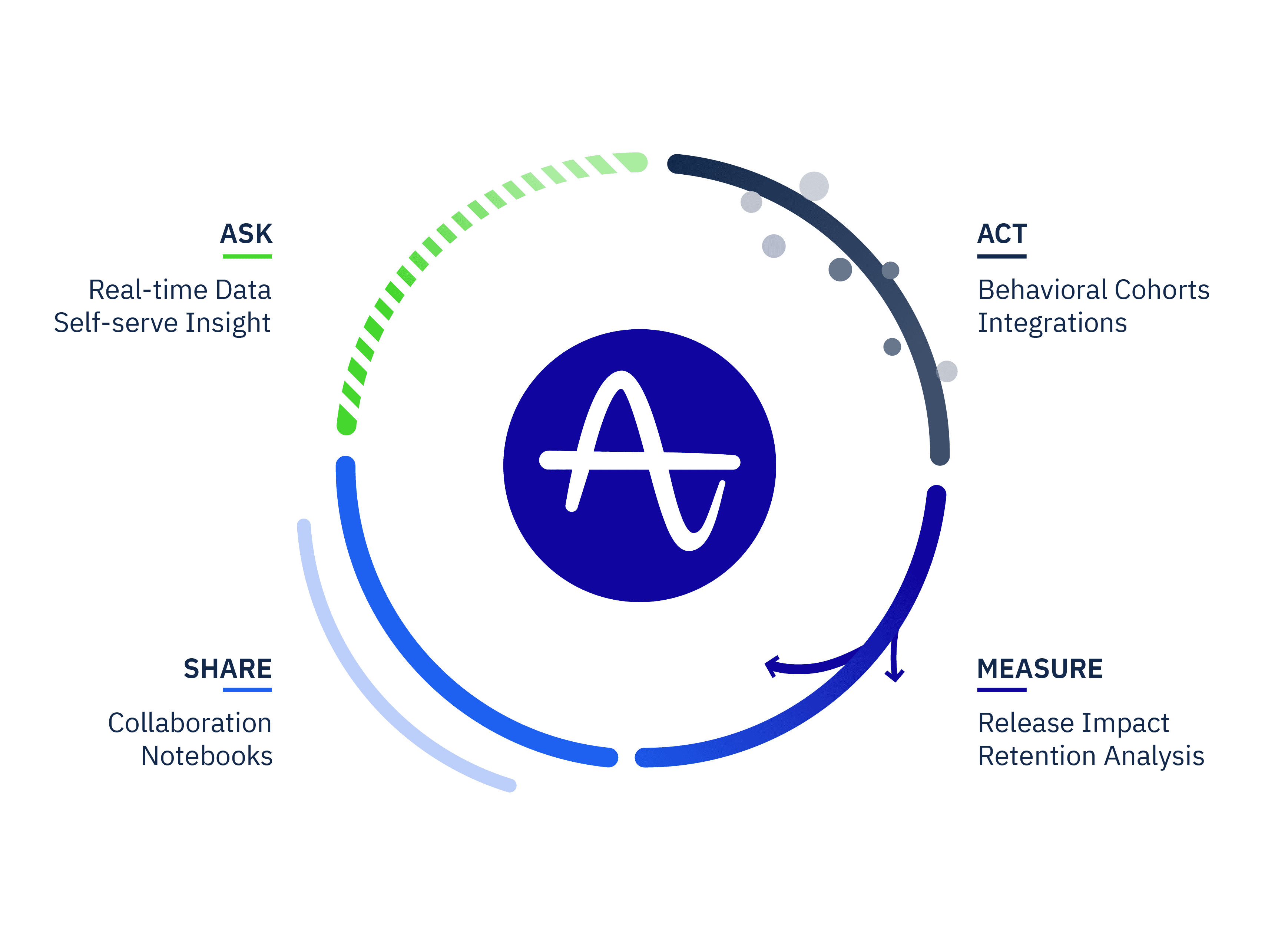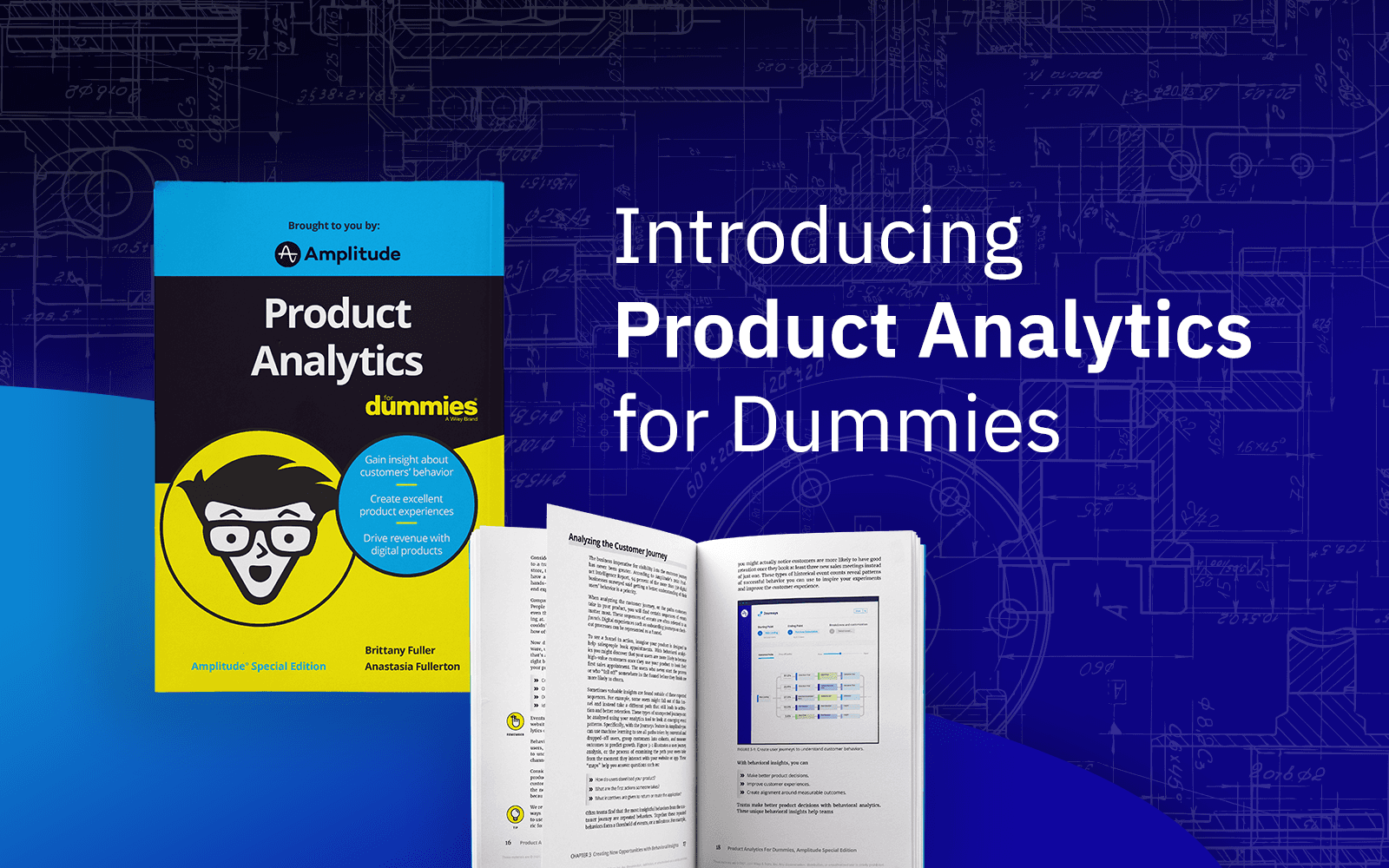Introducing Product Analytics for Dummies
Understanding product analytics is the first step towards delivering continual value to customers and driving growth with your digital product.
Product analytics sits at the intersection between your customer, your product, and your business goals. It’s a crucial part of how you provide continual value to customers, as well as how you grow your business. Product analytics keeps your team close to customer wants and needs throughout the product development process.
Adience’s research highlights the power of product analytics. When they spoke with over 350 product development leaders for Amplitude’s 2020 Product Intelligence Report, they found that 44% of the companies we surveyed grew by at least 25% by using product analytics as a part of their growth strategy.
44% of the companies we surveyed grew by at least 25% by using product analytics as a part of their growth strategy.
Product analytics provides visibility into these desired outcomes, helps connect those outcomes to business goals, and makes it easy to drive growth as a cohesive and collaborative team.
Working with Wiley Books, we’ve put together a Product Analytics for Dummies resource to help you get started. This blog post introduces some of those ideas, so you can learn more about the world of product analytics and how it creates value for your customers and your business.
What Is Product Analytics?
At its core,product analytics is the process you use for understanding how customers engage with your digital product or service. It is a framework for putting your customers at the core of your business by looking at behavioral data, identifying high-value opportunities, and creating impactful experiences. Product analytics lets your team track, visualize, and analyze real-time engagement and behavioral data so you can optimize your complete customer journey.
The 5 Parts of Product Analytics
Product analytics is made up of five interconnected processes:
- Data management: Deciding what kind of data you want to track and how to manage it
- Behavioral insights: Identifying high-value opportunities through behavioral data
- Product-led growth: Driving revenue and growth through your product experience
- Targeting and recommendations: Targeting specific audience segments based on their needs
- Collaboration: Creating a company culture that’s focused on driving growth, together
By analyzing these processes and the outcomes they produce, your team can see how customers experience your product, not how you think they experience your product.

Part 1: Use Data Management to Build a Solid Knowledge Base
Data management is the process of collecting actionable data to inform the decisions you make throughout the product development process. It is the first step towards making product analytics valuable for your team and creates visibility into important takeaways. As your company grows, strategic data management ensures that any customer information is easily accessible to team members and trustworthy.
Proper data management is all about understanding what data your team needs and why they need it. It helps you contextualize the platforms and tools you use to track information, how that information is gathered through those tools, and how your team intends to use data to inform their decisions and create value for your customers.
Think about data management as the framework you use for defining the way your team works with data. It ensures that the right data is available to the right people at the right time. This accessibility can 10x the value of your data.
A big part of data management is data governance. Data governance ensures that all the information available to your team is secure, accurate, and as up-to-date as possible. As your team grows, being able to share this data at scale helps make the rest of product analytics easier for your team.
A strong data management strategy helps your team make use of all the valuable customer data without having to endlessly search for it.
Part 2. Achieve Your Business Goals with Behavioral Insights
Your team gathers behavioral insights by observing how your customers interact with your product or service. It’s the next layer up from raw data and helps your team understand users on a deeper level. When you have a clear view of the customer’s experience with your product, it’s easier to deliver continual value with each release.
These behavioral insights connect what customers say they want with what they actually need. Whenever someone interacts with your product in a specific way, their behavior provides insight into their overall experience with your company. Understanding the divide between customer behavior and customer intent is how you build products that are truly valuable for your customers.

But useful insights are dependent on being able to track important aspects of the cross-channel customer journey—one action doesn’t add up to the entire experience. A strong focus on product analytics helps you keep track of important touchpoints at each stage of the journey and build a comprehensive picture of how people interact with your product.
This comprehensive picture of customer behavior helps your team make smarter decisions about your long- and short-term product strategy, as well. When so much of the customer experience depends on your ability to consistently provide value to customers throughout their lifecycle, behavioral insights are what guide your development choices.
Part 3. Make Product-Led Growth Part of Your Company Culture
Being product-led is a cross-functional team mindset built around the idea that digital products are at the core of business success. This doesn’t mean that products replace other growth levers, like sales or marketing—being product-led depends on company-wide collaboration to create the best offerings for your users.
One of the core tenets of a product-led growth strategy is that products exist as both a revenue engine and a competitive differentiator. It is the thing that attracts customers, convinces them to pay, provides them with value, and keeps them engaged.
Becoming a product-led organization follows five stages and incorporates five common growth tactics.
The 5 Stages of Product-Led Growth
- Acquisition: Using your product to acquire new customers on its own
- Engagement: Encouraging engagement with your product through consistent use
- Revenue: Generating revenue through the product experience
- Retention: Boostingcustomer retention and engagement through product usage
- Expansion: Using your product to promote and offer upsells or new purchases
Product-Led Growth Tactics:
- Education: Educating customers through your product builds a better experience
- Optimization: Improving your product by enhancing existing features or functionality
- Experimentation: Testing new product ideas with potential customers
- Behavioral Targeting: Targeting the right audiences at the right time
- Recommendations: Using behavioral insights to make relevant recommendations
These five stages and growth tactics progress in a similar way to the customer’s journey with your product. It’s a way to visualize the entire product experience and add value at key points along the way.
Part 4: Use Personalized Targeting & Recommendations to Boost Engagement
Being able to make personalized recommendations are table-stakes in today’s B2B and B2C technology markets. According to research done by Harvard Business Review and Amplitude, 81% of digital product leaders say our users’ expectations for great digital experiences have never been higher, report coming in Jan 2020. Modern consumers expect companies to understand their needs when they interact with their products.
Making personalized recommendations boosts engagement with your product. It shows the user that you understand them—which increases loyalty and fosters the kind of engaged relationships that grow and sustain your business.
Personalization can drive up to a 30% improvement in revenue and retention, and up to a 20% reduction in marketing costs. – McKinsey
Providing your audience with relevant recommendations is only possible when you understand how users interact with your product. Product analytics helps your team understand the different personas you’re targeting with products. It gives them a way to empathize with the customers’ needs and deliver something of value at specific points in their journey.
Behavioral targeting helps you break down your audience into defined cohorts with shared characteristics. Whether it’s their wants and desired outcomes, their personally identifying information (PII), or their behavior, understanding the various different types of people who make up your customer base helps you tailor your recommendations to their specific needs.

Behavioral cohorts via Amplitude.
As you make these recommendations and track their impact, you also gain a more comprehensive picture of customer behavior as a whole. Being able to accurately predict customer behavior also makes it easier to build the types of products they’ll actually use.
Product analytics shows you how customers behave when they engage with your product, where they thrive, and potential issues that get in their way. Moving away from a one-size-fits-all mentality ensures that each customer gets exactly what they need from your product.
Part 5: Collaborate to Make Data-Driven Decision-Making Easy
Becoming a product-lead organization only works if every member of the team believes product-led growth driven by product analytics is the path to success. Product analytics is a team sport. Building a team that’s engaged with the customer and empathetic to their needs promotes open and honest collaboration across and within teams.
That kind of collaboration increases visibility in the various data points and behavioral insights required to make smarter decisions for customers. As you’re getting started with product analytics, the Ask, Act, Measure, Share Framework can be a useful tool for helping your team engage with data on a deeper level.
This framework inspires your team to discover more about customers, experiment on hypotheses, measure outcomes, and build a more comprehensive understanding of your product’s impact.

This learning framework helps your team engage with product analytics at each point of the product development process. That makes it easier for your team to ask the right questions, act on their assumptions of the data, measure the impact of their actions, and share those insights with the organization.
This framework makes your teams accountable to your business and accountable to your customers.
Being able to tie each step of the customer lifecycle back to a concrete data point or behavioral insight helps each member of your team stay focused on the customer and the business value of their ideas. And that shared understanding helps bring everyone together to deliver the best possible product experience as a team.
Check Out Product Analytics for Dummies Today
Understanding how to leverage data to build better products is the key to creating a positive, memorable customer experience. To learn more about how you can get started with product analytics, check out our Product Analytics for Dummies book.

Anastasia Fullerton
Former Senior Product Marketing Manager, Amplitude
Anastasia is passionate about sharing powerful stories and sour candy (if you live in SF check out her favorite spot, Giddy Candy, on Noe St). Since she got her degree in engineering from Stanford, she’s been digging through data to find strong stories. At Amplitude, she helped companies understand the impact of empowering their teams with analytics and building better customer experiences.
More from Anastasia




